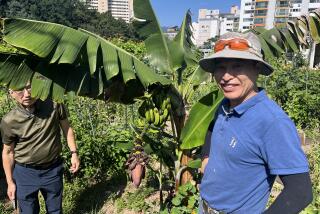Banana Nature
- Share via
Bananas are among those industrial fruit you count on to be there every week without fail. You buy them almost by reflex and never give them a second thought. Well, most of the time.
Over the last month or so, I’ve been getting lots of questions about bananas.
Many inquiries were triggered by Hurricane Mitch. Would prices rise because of the damage it caused in Latin America?
It’s still too early to tell for sure, but most experts are predicting a slight but not drastic price rise, at most a 15% increase over the next year. One reason: Banana prices had been at their lowest point in years just before the hurricane. Also, though the hurricane devastated banana plantations in Nicaragua, Guatemala and Honduras, those countries account for only about 25% of what is sold in the United States.
Other banana questions were more complex, so we went to Marta Maitles, director of communication at Westlake Village’s Dole Fresh Fruits--one of the nation’s leading importers of bananas--for answers.
One reader, for example, wondered why some of his bananas didn’t ripen. Their skins turned grayish rather than golden, and the meat didn’t soften.
“Chances are that’s chill damage,” Maitles said. “When bananas get that gray hue, it’s usually because they got too cold at some point in the distribution system. If the temperature falls below 56 degrees at any point prior to ripening, it can cause damage.”
So sensitive are bananas that merely being left in a too-cold storage room or being parked too near the frozen goods on a loading dock can cause this problem. And, of course, you don’t want to put them in the refrigerator.
“The problem is, those bananas will look fine until they ripen. And unfortunately, they usually don’t ripen until after you take them home. If that happens, it’s important to take them back to the store and let them know that this has happened so they can let us know there’s a problem. That way we can trace it.”
Another reader wondered about the little black spots that were suddenly appearing in the center of her bananas. Were they insect infestations?
Certainly not, said Maitles; they’re seeds. Well, they’re not really seeds, because technically bananas don’t have seeds; the trees sprout from bulbs. Actually they’re a botanical anomaly called false seeds. And they occur in a surprising number of bananas, only most of the time you don’t notice them because they’re so light in color.
Bananas also vary quite a bit in size and shape. This is not varietal; the vast majority of the full-size breakfast bananas sold in U.S. supermarkets are Cavendish. Whether they’re large or curved or have angular ridges on their peels has more to do with where and how they’re grown.
“That’s just nature,” Maitles said.
More to Read
Eat your way across L.A.
Get our weekly Tasting Notes newsletter for reviews, news and more.
You may occasionally receive promotional content from the Los Angeles Times.











